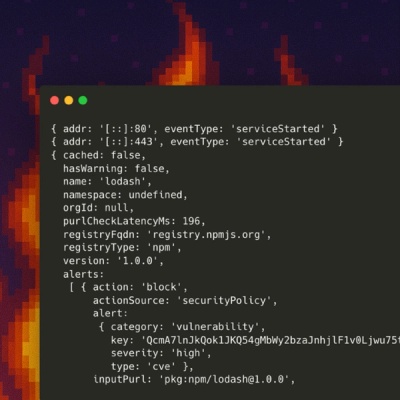
Research
/Security News
10 npm Typosquatted Packages Deploy Multi-Stage Credential Harvester
Socket researchers found 10 typosquatted npm packages that auto-run on install, show fake CAPTCHAs, fingerprint by IP, and deploy a credential stealer.
@onbeam/sdk
Advanced tools
The Beam Web SDK is a Typescript library that allows you to easily integrate Beam into your website, application or web-based game. It provides a simple API to authenticate your users on Beam, manage sessions and sign transactions, and access the Beam Player API.
Before you start, make sure you obtain an API key by requesting it through build@onbeam. More information can be found on the Beam API Docs.
To get started with the SDK, install it in your project using your favorite package manager:
# with npm
npm install -S @onbeam/sdk
# or with yarn
yarn add @onbeam/sdk
# or with pnpm
pnpm add @onbeam/sdk
Start by creating a new instance of the Beam client, and configuring it with the chains you want to use. We're using the Beam testnet chain in this example:
import { BeamClient } from '@onbeam/sdk';
import type { ClientConfig, ChainId } from '@onbeam/sdk';
const config: ClientConfig = {
chainId: ChainId.BEAM_TESTNET,
chains: [
{
id: ChainId.BEAM_TESTNET,
publishableKey: 'your-beam-api-key'
}
],
debug: true, // Logs debug information to the console
};
const client = new BeamClient(config);
Make sure your API key matches the environment you are working on.
If you're using wagmi, you can authenticate a user by providing the wagmi config with our EIP-6963 compatible wallet provider. First, provide the wagmi config with
the injected connector. Then, create a new Beam client and connect the provider:
import { createConfig, http, WagmiProvider } from 'wagmi'
import { beamTestnet } from 'viem/chains';
import { injected } from 'wagmi/connectors';
import { QueryClient, QueryClientProvider } from '@tanstack/react-query';
import { BeamClient } from '@onbeam/sdk';
// Create the wagmi config and provide the 'injected' connector
const wagmiConfig = createConfig({
chains: [beamTestnet]
connectors: [
injected(),
],
transports: {
[beamTestnet.id]: http(),
},
});
const queryClient = new QueryClient();
// ... using the `config` from the previous example
const beamClient = new BeamClient(config);
// Connect and announce the provider
beamClient.connectProvider();
export default function App() {
return (
<WagmiProvider config={wagmiConfig}>
<QueryClientProvider client={queryClient}>
<YourApp />
</QueryClientProvider>
</WagmiProvider>
);
}
Our wallet provider is EIP-6963 compatible and supports wagmi 2.x and above.
The repository includes two example apps that demonstrate how to use the Beam Web SDK:
The SDK example app demonstrates how to create and manage sessions for your players and is mainly suited for game developers that wish to integrate Beam into their games.
The Wagmi example app demonstrates how a 'Connect with Beam' wallet integration can be implemented in a web application. It is mainly suited for NFT marketplaces or web applications that require users to authenticate with a wallet and interact with the Beam chain.
For more information and API references, check out our online documentation.
FAQs
Beam Web SDK
The npm package @onbeam/sdk receives a total of 146 weekly downloads. As such, @onbeam/sdk popularity was classified as not popular.
We found that @onbeam/sdk demonstrated a healthy version release cadence and project activity because the last version was released less than a year ago. It has 6 open source maintainers collaborating on the project.
Did you know?

Socket for GitHub automatically highlights issues in each pull request and monitors the health of all your open source dependencies. Discover the contents of your packages and block harmful activity before you install or update your dependencies.

Research
/Security News
Socket researchers found 10 typosquatted npm packages that auto-run on install, show fake CAPTCHAs, fingerprint by IP, and deploy a credential stealer.

Product
Socket Firewall Enterprise is now available with flexible deployment, configurable policies, and expanded language support.

Security News
Open source dashboard CNAPulse tracks CVE Numbering Authorities’ publishing activity, highlighting trends and transparency across the CVE ecosystem.